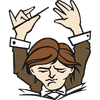I’ve spent a few months analyzing the Tomb in order to give my players the best experience. I wanted to really make sure I understood the dungeon so that we wouldn’t run into any dungeon breaking mistakes in rulings. I’m ready to present my findings here, both to benefit others and to get feedback in case I’m overlooking something myself. Particularly with the 1e AD&D rules which I’m not familiar with.
Format
“Eight groups of fifteen pregenerated characters were decimated in the Tomb at the first Origins convention, which took place from July 25 through 27, 1975, in Baltimore, Maryland. Players had only two hours to get as far as they could in the dungeon…” (Witwer 2018)
ToH was designed for tournament play with competing groups being scored. We can see throughout how that format informed the design of the dungeon. Many elements are placed simply to waste time at the table: probing for the entrance, puzzles with no clues, elaborately hidden secret doors. The linearity also speaks to the goal of scoring. Most branches are one or two rooms off the main path that dead end or loop back. You can go from the Great Hall to the Second Great Hall via the Archway and Statue or through the Gargoyle and Complex. You can detour to the Grotto, but there’s nowhere to go but back from there. As we deep dive into the Key to the Tomb we’ll see these elements again and again.
“You don’t have to run faster than the bear to get away. You just have to run faster than the guy next to you.” — Jim Butcher
The fundamental design of the dungeon wasn’t for you and your friends to play through all the content over several sessions. I’ll say that again louder for those in the back, this dungeon was not designed for all players to play though all the content. It was designed for a smash and grab; get in, get as much treasure as you can, as deep as you can, and get out alive. And hope you scored better than the next table over. There are plenty of reasons to call this a bad module, but to call it bad because it wasn’t designed for your preferred format is dumb.
Time Wasting
“…the volume of items within it is calculated to waste time for the players.” (Gygax 1978)
Time management is the primary way this dungeon challenges its players. There’s too much junk to be thorough and make progress in the allotted time. Each path forward requires searching for the location of a secret door, aside from the first archway. Even elements that may provide a boon require significant investigation and debate. Do you crush all your gems for an unknown reason? Do you swipe the sacks or the lady?
Skill Play
“Original D&D and Swords & Wizardry are games of skill in a few areas where modern games just rely on the character sheet…you are always asking questions, telling the referee exactly what your character is looking at, and experimenting with things. Die rolls are much less frequent than in modern games.” (Finch 2008)
“Gary, I look up, and down, and all around the area before I walk in. That stopped a lot of ugly surprises from happening.” — James Ward
Traps are deadly because there are no dice rolls to reveal them. Experienced players of the day would carefully check the way forward in dangerous environments. Warily eyeing the ceiling. Poking everything with the proverbial 10’ pole.
This is what Gygax means about a “thinking person’s module.” Not that the puzzles are clever or there are clues that need deciphering, but that the module is more exploration and less roll dice monster slaying. Though given Gygax’s reputation I’m sure he thought his puzzles were clever.
Dungeon
We’re going to use a level 12 fighter from 1e and 5e to compare the survivability of each room. We’ll take the average for all rolls.
1e:
- Human fighter
- 17 years, max 94 years
- Cha is more valuable for retainers
- Str 13 dex 11 con 12 int 8 wis 9 cha 10
- 75 lbs 2 languages 4 retainers
- Plate Armor AC 3 75 lbs
- Shield AC -1 15 lbs
- Sword 5 lbs
- AC 2 and 9” movement
- 9+9 hd is 58 hp
- Saves, vs poison 7, vs spells 10
- 1 1/2 attacks per round
5e:
- Human fighter
- +1 to all attributes
- Wis is more valuable for perception
- Str 16 dex 14 con 15 int 11 wis 13 cha 9
- 4 ABIs
- Str 20 dex 14 con 19 int 11 wis 13 cha 9
- Plate Armor AC 18
- Shield AC +2
- AC 20
- 12d10+12*4 hd is 114 hp
- Proficiencies, Saves str con, Skills perception athletics
- 3 attacks per round
Start
1e: Here we are, the very first dungeon area and it’s the epitome of the design, eating your time. There are 34 10’ squares, each one takes 10 minutes to search, about five and a half hours to search thoroughly or unluckily. After locating an entrance it takes an additional 10 minutes to clear a crawl space or 1 hour to clear completely with the party working together.
5e: Not sure why they dropped the length from the description, but the accompanying map is about 34 squares across.
False Entrance Tunnel, West
1e: The module explicitly disallows any saving throw if the player didn’t probe for traps. This trap will deal 47% (27 hp) on average.
5e: The fighter has a 50% chance of discovering the nature of the trap.
They will save 35% of the time. On a fail, they’ll take 24% (27 hp) damage. Changing this to 10d10 for 48% (55 hp) would be comparable.
False Entrance Tunnel, East
1e: Count up, so as not to give away how much time is allotted, to 10 in 15 seconds out loud, as implied by the False Crypt, and note at what count a PC is fleeing. The PCs will move 1’ per their movement rate per remaining count (i.e. 12” move 12’ and 3” move 3’ per remaining count). The stone slab moves 20’ in 9 counts, only protruding a little on count 1. The character who triggers the trap will need to move 30-40’ depending on which side of the hall they were on to clear the slab. At 6’ of movement, assuming our fighter is carrying additional gear, starting on the east side, they need to start moving by count 3 or be trapped.
5e: Our fighter will spot the trap 50% of the time.
Roll initiative. In a single round, the slab will move all 20’. At each initiative count after 20 the slab moves 1’. The map squares are 10’ not 5’, this is a mistake in the conversion. At initiative count 4 its double movement to squeeze between the slab and wall. At initiative count 2 the space is too small for a medium or small creature to squeeze through.
Credits
Tyler Jacobson Cover illustration for Tales from the Yawning Portal https://www.inprnt.com/discover/image/tylerjacobsonart/tales-from-the-yawning-portal
Jeremy Crawford, Michele Carter, and Kim Mohan Tales from the Yawning Portal https://dndstore.wizards.com/us/en/product/819134/tales-from-the-yawning-portal-digital-plus-physical-bundle
Gary Gygax Tomb of Horrors https://www.drivethrurpg.com/en/product/176871/s1-tomb-of-horrors-1e
Gary Gygax Advanced Dungeons & Dragons https://www.drivethrurpg.com/en/product/17003/players-handbook-1e https://www.drivethrurpg.com/en/product/17004/dungeon-master-s-guide-1e https://www.drivethrurpg.com/en/product/17002/monster-manual-1e
Michael Witwer, Kyle Newman, Jon Peterson, Sam Witwer Dungeons & Dragons Art & Arcana: A Visual History https://www.penguinrandomhouse.com/books/562708/dungeons-and-dragons-art-and-arcana-by-michael-witwer-kyle-newman-jon-peterson-and-sam-witwer-foreword-by-joe-manganiello-official-dungeons-and-dragons-licensed/
Matthew J. Finch and Mythmere Games Quick Primer for Old School Gaming (2024) https://www.mythmeregames.com/products/quick-primer-for-old-school-gaming-pdf-free
We’ll pick up next time with the Entrance to the Tomb.
Very interesting post. My group is in the tomb right now, playing Pathfinder 2 and using The Alexandrian’s version.
The time wasting aspect is definitely visible, and that it’s about real-world time and not in-game time. There is nothing stopping you from calling it a day after an in-game hour of non-stop spellcasting and coming back tomorrow.
Another aspect which made a huge difference is the capacity for regenerating HP. There was very limited regeneration in 1e, whereas in Pathfinder, if you’re not under time pressure, you can heal back up to full indefinitely. I have tried to give the traps additional effects beyond HP loss.
I definitely agree about the the HP and other resource management. I’ll be covering some of that in my next post.
In my version, I expanded on the idea of the demons that show up when you go astral or ethereal. They also come in after about a day to repair damage to the tomb and reset (most) traps. Resetting the traps is mostly a curiosity, since the players know how they work the second time. But they may actually run into the demons themselves who would not like to be disturbed in their work. That can add an element of danger and dissuade the players from wasting time. Of course they can just rest outside of the tomb, as long as they have actually found the way out.
Cool post! Never knew it was competitive
Sometimes I think I would love to try playing AD&D in the competitive Gygax method. It would be fun to get a table of skilled players and complete against another table to see how far you can get through a dungeon and get the most gold. It seems like a wildly different way to play and would be kind of fun for a competitive - cooperative method.
This is really cool. Thank you!


